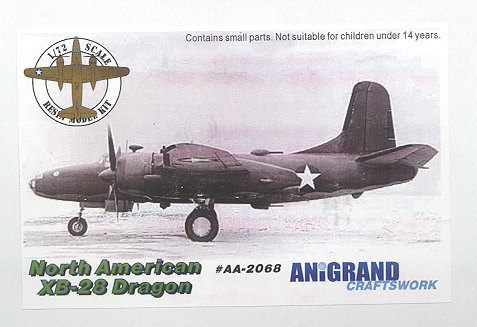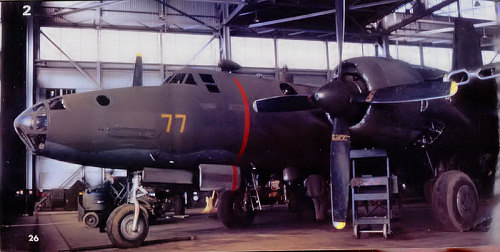
| KIT: | Anigrand 1/72 North American XB-28 |
| KIT #: | AA-2068 |
| PRICE: | $64.00 from www.NostalgicPlastic.com |
| DECALS: | One option |
| REVIEWER: | Scott Van Aken |
| NOTES: | Resin with vacuformed canopy |

| HISTORY |
The USAAC was in need of a high altitude bomber to supplement the B-25 Mitchell and in response, North American aviation produced their model NA-63, later designated XB-28. The first of two test aircraft (40-3056) first few in April of 1942; twenty six months after the order was placed.
The XB-28 bore no similarity at all to the B-25 with a circular fuselage and 'standard' empennage. Two P&W R-2800-27 engines with superchargers, each developing 2,000 hp were installed, driving a four blade prop. Each prop turned in opposite directions to reduce torque. Remote control ventral and dorsal turrets were installed along with a tail turret, each carrying twin .50 calibre machine guns. The gunners sat in the rear section of the cockpit and sighted through periscopes.
A 4,000 pound bomb load was carried with the plane having a service ceiling of 34,600 feet. A top speed of 372 was attained, far above that of contemporary production aircraft. Normal cruise was 255 mph.
However, the USAAF had developed lower altitude bombing to such an art, that the need for a high altitude medium bomber disappeared and with it the need for the XB-28. However, high altitude reconnaissance was still needed and the second airframe (40-3058) was developed to this end. The nearing end of the war and conversion of existing types (like the B-29) made the aircraft redundant as well.
The prototype bomber was originally in unpainted metal with an OD nose anti-glare panel and red, white and blue striped rudder. Later photos show it still unpainted but with the rudder stripes removed, save for those on the trim tab. It was then painted in Olive Drab over Neutral Grey.
| THE KIT |
 It
is difficult to not sound like a broken record when describing Anigrand kits,
but here goes anyway. Tan resin; nicely done but a bit large engraved detail;
Spartan cockpit with two seats, two control sticks and an instrument panel. A
bombardier's seat is also given. Care will be needed to provide enough weight
for this one to sit on all three gear. The area normally used for weights will
be visible through the nose transparency. There is space behind the cockpit, but
this locale will require more weight, putting additional strain on the resin
nose gear.
It
is difficult to not sound like a broken record when describing Anigrand kits,
but here goes anyway. Tan resin; nicely done but a bit large engraved detail;
Spartan cockpit with two seats, two control sticks and an instrument panel. A
bombardier's seat is also given. Care will be needed to provide enough weight
for this one to sit on all three gear. The area normally used for weights will
be visible through the nose transparency. There is space behind the cockpit, but
this locale will require more weight, putting additional strain on the resin
nose gear.
The main wheels are accurate for this aircraft as photos show a blank wheel cover. Photos show a blank wheel cover on the nose wheel, but the kit offering has circular slots. Wheel wells have the usual 'guesstimate' of what's there with a criss-cross of square braces. Engines are quite nicely done and give you a full forward bank and half rear bank. I am not sure if Anigrand took into account the opposite engine rotation with the prop blades or not as I didn't open the bag with the small bits as I inevitably lose or have broken these small bits when I do so. The markings guide shows them turning inboard so perhaps they did. Turrets are also well molded with slots for the guns. Resin blanks are provided and I suggest replacing them with tubing of some sort. The sighting periscopes are also give. All of the small parts seemed quite well molded with no molding faults. I'd again suggest that Anigrand think about doing seat harness decals and perhaps a generic instrument panel blank that we can cut to shape whatever kit we are doing. May not be accurate, but will add quite a bit to the look of the cockpit.
The major resin bits are also nicely done. In my ever ongoing quest for glitches, I was able to find a few. Both wing tips suffer from large air holes with a couple of smaller ones tossed in. I also found these on the tips of the stabilizers and fin as well as at the back of the engine nacelles. Fuselage halves were devoid of these, though the left half did have a rather large 'pimple' of resin on the forward portion. These will all be easy to repair. The flight surfaces are all provided with pins to fit into holes in the fuselage. As often happens, some of these were either broken off or quite short. Length is not a problem as long as something is there to help alignment. The broken ones can be replaced by drilling the area out and inserting a section of rod.
 Instructions
are the now 'new' version with the exploded view and parts listing on one side
with the history and painting/decal guide on the other. A sheet of
decals is provided for the insignia and the nose number (77). I could find no
photos of this plane with this nose number nor with any serial number on the
fin. During at least one time in its life, it carried de-icer boots on the
leading edges of the flight surfaces.
Instructions
are the now 'new' version with the exploded view and parts listing on one side
with the history and painting/decal guide on the other. A sheet of
decals is provided for the insignia and the nose number (77). I could find no
photos of this plane with this nose number nor with any serial number on the
fin. During at least one time in its life, it carried de-icer boots on the
leading edges of the flight surfaces.
 Late
entry: Thanks to a posting on the forum, I have a photo of the plane with the
nose number and you can also tell which way the props turn. The instructions are
misleading as the engines appear to turn outboard.
Late
entry: Thanks to a posting on the forum, I have a photo of the plane with the
nose number and you can also tell which way the props turn. The instructions are
misleading as the engines appear to turn outboard.
| CONCLUSIONS |
We have yet another fine prototype from Anigrand and I'm glad to see them. Anigrand kits are relatively easy to build and provide a superb basis for additional detailing. This one seems to be as good as the others and would be a nice introduction to the genre if you've never tried a resin kit.
| REFERENCE |
US Bombers: B-1 to B-70. Lloyd S. Jones, 1962, Aero Publishers
December 2006
My thanks to Anigrand USA for the review kit. Get yours from the hyperlink and pay no shipping in the US.
If you would like your product reviewed fairly and quickly by a site that has over 325,000 visitors a month, please contact me or see other details in the Note to Contributors.